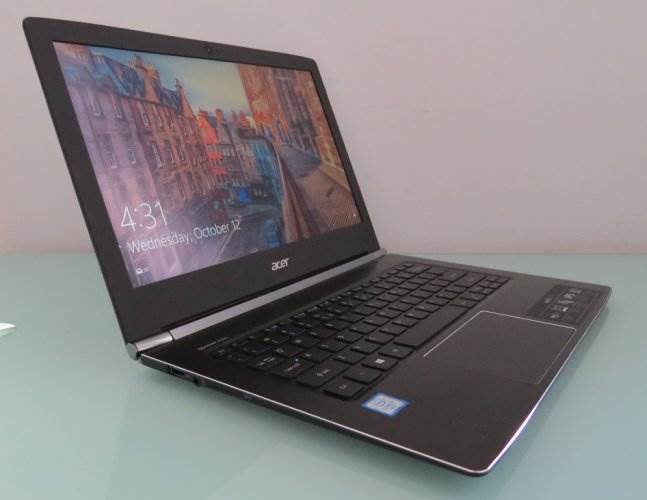For the past few years Asus has kind of dominated the affordable ultrabook space with its Zenbook UX305 line of 13.3 inch notebooks weighing around 3 pounds or less and selling for around $699 and up.
But this year Acer decided to get in on the action with the launch of the 3 pound Acer Aspire S 13 ultrabook with a starting price of $699. Unlike most Zenbook UX305 models, Acer’s compact laptop has a backlit keyboard. And while the cheapest Zenbook laptops have Intel Core M processors, all of the 2016 Acer Aspire S 13 laptops have Core i5 or faster chips.

After using the same Samsung Series 9 laptop for 4 years, I was in the market for a new laptop with a faster processor and better battery life. So when the Microsoft Store recently knocked $200 off the price of the Acer Aspire S 13 I decided to pick up a model with a Core i7-6500U processor, 8GB of RAM, 256GB of storage, and a matte touchscreen display.
Normally this model would sell for $899, but I was able to score one for $699. After spending a few weeks with the laptop, I can say it’s probably worth the list price, and it’s definitely a good deal if you can find one on sale like I did.
But that’s not to say Acer’s laptops are no-compromise computers. The Aspire S13 has a fan that can get rather loud at times. The bezel around the screen is large enough to annoy people who don’t like big bezels. And I’m still getting used to Acer’s quirky keyboard layout.
In terms of performance, battery life, and display quality though, I have few complaints.
[embedded content]
Overview and design
The model featured in this review is an Acer Aspire S 13 with a Core i7 Skylake processor, 8GB of RAM, 256GB of storage, and a 1920 x 1080 pixel matte IPS touchscreen display. It features Windows 10 Home 64-bit software, 802.11ac WiFi and Bluetooth and a backlit keyboard.
Unlike most of the computers I review, I bought this laptop with my own money and paid $699 plus tax for it.


The notebook has some premium design elements, but it’s relatively affordable for a machine that measures 0.6 inches thick, weighs 3 pounds, and features a Core i7 processor, touchscreen, a full HD display, and a magnesium-alloy body (with some plastic around the lid and display area).
It’s available two different color schemes: white with gold-colored trim, and black with a silver/chrome trim. My model has the dark design.


The laptop measures 1.9″ x 9″ x 0.6″, which makes it just enough bigger than my old laptop to keep it from fitting comfortably into my old slip cover, so I had to spend a little money on a new one.
It’s also about half a pound heavier than my Samsung Series 9 notebook… but I’m willing to put up with a little extra weight for a battery that lasts more than twice as long.
On the right there’s a USB 3.0 port, a full-sized HDMI port, a status LED and a power jack. There’s also a USB 3.1 Type-C port which is used for data, but not for charging.


The left side of the laptop has another full-sized USB port, a headphone/microphone combo jack and a full-sized SD card reader.


About that card reader though: you’re probably not going to want to leave an SD card plugged in permanently, because it will stick out quite a bit from the side of the laptop.


The fact that storage cards don’t sit flush with the laptop probably isn’t a big deal if you’re just trying to copy some pictures from your camera before returning the card to your DSLR. But if you were hoping to use an SD card to supplement the laptop’s built-in storage, you’ll ruin the aesthetics of the computer a bit and maybe run the risk of having it bump into things and fall out.
There’s no Ethernet port, and unlike some laptops that lack an RJ-45 jack, the Aspire S 13 didn’t come with an adapter. So I picked up an Aukey USB C USB C hub with 3 USB 3.0 ports and a Gigabit Ethernet jack. It’s not something I’ll use often, but it comes in handy when I’m working remotely at events like the Consumer Electronics Show.


While some bezel-haters will take one look at the screen and get too distracted by the thick borders around the sides to focus on the display itself, I personally have nothing against a bezel — and sometimes they can come in handy.
While the Dell XPS 13 line of laptops look pretty sleek thanks to their super-slim bezels, the border above the screen is too small to accommodate a webcam, so Dell awkwardly squeezes one into the space below the screen — where it gets a good view of your chin (or other body parts) while you’re on a video call… assuming your fingers aren’t in the way. That’s not a problem with the Acer Aspire S 13, which has a camera above the display.


As for the screen itself, it’s a full HD display with wide viewing angles and a matte finish. That means some colors might not pop the way they do on a glossy screen. But it’s much easier to use laptops with matte displays outdoors or near windows since they don’t reflect as much glare from the sun or other bright light sources.
The screen also supports a respectable range of brightness settings, allowing you to dim the display when you’re in a dark room or brighten it to make the screen easier to see outdoors or in other bright spaces.

Facing a sunlight window
The laptop’s hinge can open wide, allowing you to push back the screen more than 160 degrees. It doesn’t quite fold down flat, but it comes pretty close.


Matte screens are a rarity these days, but the Aspire S 13 featured in this review is something of a unicorn: it has a matte display and a touchscreen. While this is a notebook and not a tablet, I’ve found that sometimes it does feel comfortable to reach up and touch the screen to open apps, drag and drop files, or perform other actions.
This is especially true when the notebook is resting on my lap or when I’m standing over the laptop as it rests on a table. When I’m using it from a seating position with my arms outstretched and palms resting to the sides of the touchpad, it’s often more comfortable to use the touchpad or a mouse.
Still, it’s nice to have the option of tapping, swiping, and dragging. I did disable the on-screen keyboard so that it wouldn’t show up every time I touched a text input box.


One weird quirk about the Aspire S 13’s display is that it doesn’t feature the same edge-to-edge glass that you’d normally expect from a touchscreen laptop with a glossy screen. Instead, the display panel is recessed a bit, and that means when you try to tap on something close to the edge of the screen your finger may hit the bezel instead of the touchscreen.
That can make it hard to do things like select web browser tabs or other elements at the top of the screen. It also makes swiping from the edge of the screen a little odd, since your finger will often start on the bezel, and then slip backward a bit to reach the screen.


I also adjusted the display scaling to 126 percent in order to comfortably view the software I use most on a laptop. While you could certainly use 100 percent scaling, I find that I often have to squint or move my head too close to the screen to read text on a 13.3 inch full HD display when I do that.
Things look much better at 125 percent scaling, but at that setting the Google Chrome web browser gives me an inconsistent view: web content looks larger, but the menu bar, tabs, and other navigational components look too small. Using a custom scaling option of 126 percent resolves that issue. Go figure.
Like most portable notebooks released in the last few years, the Aspire S 13 has a battery that’s not meant to be removed and a case that’s not meant to be opened. But if you flip over the computer you’ll find that the bottom panel is held on my 10 screws which are fairly easy to remove.


Once inside, you can swap out the M.2 SSD if you want more than 256GB of storage. The WiFi module can also theoretically be replaced if something goes wrong with the one that comes with the laptop.
The RAM, however, is soldered to the motherboard. If you think you might need more than 8GB, then you may want to invest in a different laptop.
While we’re on the bottom of the laptop, I should point out that there are vents near the back of the machine, as well as vents built into the hinge. The good news is that they help keep the laptop relatively cool. The less good news is that if you use the notebook in a quiet environment you will certainly hear the fans blowing pretty regularly.


The system has stereo speakers which are also facing the bottom of the laptop. But they’re position near the left and right edges so that audio sounds reasonably clear when the laptop is placed on a desk or table. Audio can be a bit muffled if the notebook is placed on your lap.


Like most laptop speakers, the ones Acer used for the Aspire S 13 don’t provide a lot of bass, but the audio is surprisingly loud, which means you can crank up the volume on treble-heavy music and have no trouble hearing it from across the room.


The lid has grooves that make it look a bit like a record… if records were rectangular rather than round. The area around the keyboard and touchpad has a brushed metal finish. It’s nice to look at initially, but the metal surface has a habit of showing off oil smudges from your palms and fingerprints.
Keyboard and Touchpad
Acer outfitted the laptop with a Precision touchpad, which means that you can manage all of its settings through Windows 10’s mouse and touchpad settings.


It supports multi-finger taps and swipes, edge gestures, and just about anything else you’d expect from a modern touchpad.
I find it makes an audible click when pressed, but that might only really be noticeable because the keys on the keyboard are significantly quieter (the keyboard is also less noisy than the one on the Samsuner Series 9 notebook I’m replacing).
As for the keyboard, it features decent spacing, comfortable travel, and a backlight which helps…







